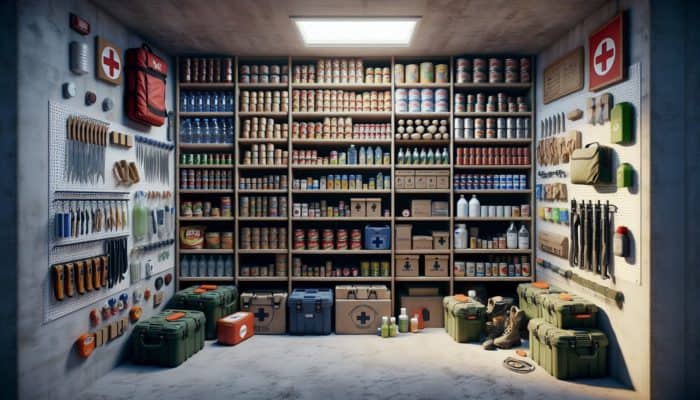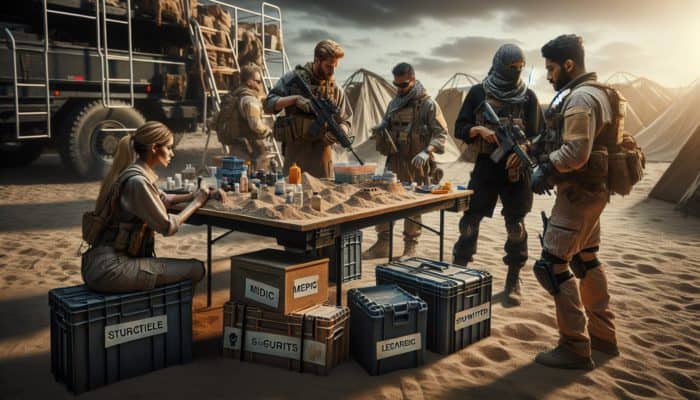Crucial Preparations to Thrive in SHTF Scenarios for Guaranteed Survival
Strategic Stockpiling of Essential Supplies for Crisis Management

In any potential SHTF scenario, meticulous planning and preparation serve as the foundational pillars of survival. By stockpiling essential supplies, you equip your team to face a multitude of challenges that may arise unexpectedly. Focus on gathering provisions that cater to fundamental needs, such as food, water, medical supplies, and critical tools. A well-thought-out stockpile significantly boosts your team’s ability to operate effectively under pressure and stress. Prioritize vital items such as:
- Non-perishable food items (such as canned goods, dried fruits, and grains)
- Clean drinking water (including purification tablets and filters)
- First aid kits (including bandages, antiseptics, and essential medications)
- Multi-tools or survival kits
- Protective gear (including gloves and masks)
- Emergency blankets and sleeping bags
- Flashlights and batteries
- Fire-starting tools (such as lighters and flint)
These indispensable supplies not only form the core of individual survival but also significantly enhance teamwork effectiveness. When every team member has access to essential resources, it fosters a deep sense of security and promotes collective efforts in resource management. This heightened level of preparedness dramatically improves survival rates and strengthens your team's collaborative dynamics.
Assembling a Diverse and Skilled Team for Maximum Survival Effectiveness
A well-rounded team is an invaluable asset when navigating the complexities of SHTF scenarios. Each member brings distinct skills and experiences, which greatly enhance the group’s ability to adapt to various challenges. It is crucial to seek individuals whose expertise complements one another, thereby creating a balanced team dynamic. Essential competencies to consider when forming your team include:
- Medical skills (such as first responders, nurses, and medics)
- Mechanical skills (including engineers and technicians)
- Leadership abilities (such as experienced leaders and motivators)
- Logistical skills (including supply chain managers and planners)
- Communication skills (such as mediators and negotiators)
- Survival skills (including seasoned outdoorspeople and foragers)
- Security skills (with military or law enforcement backgrounds)
- Food cultivation or preservation skills (like gardening experts and canners)
A team with a diverse range of expertise can adapt more effectively to unexpected circumstances, leading to superior problem-solving capabilities during crises. Regularly evaluate your team’s composition to ensure a comprehensive skill set that can tackle the numerous challenges that may arise in SHTF situations.
Establishing Strong Communication Protocols for Effective Team Coordination
Effective communication acts as a critical lifeline during SHTF scenarios, enabling your team to coordinate efforts and respond swiftly to changing circumstances. Setting up clear communication protocols is essential; these guidelines should define how team members will communicate under stressful conditions. Utilize various communication tools, such as radios or mobile phones, and supplement them with visual signals for non-verbal communication when necessary.
Regular meetings become invaluable for reinforcing these protocols. Discuss potential scenarios and assign specific roles to each member based on their unique skills. Having redundant communication methods ensures that if one system fails, alternatives are readily available. A well-structured communication plan minimizes confusion and fosters unity amidst chaos. When each team member understands their role and communicates effectively, the group’s chances of survival and success are significantly bolstered.
Insights from Experts on Effective Teamwork Strategies for SHTF Scenarios
Clearly Defined Roles and Responsibilities for Enhanced Team Efficiency
Clearly defining roles and responsibilities is crucial for optimizing team performance during SHTF scenarios. When team members understand what is expected of them, it streamlines operations and reduces confusion. Assigning tasks based on individual strengths not only maximizes efficiency but also boosts morale. For example, during a recent emergency response to a natural disaster, teams with predefined roles—such as search and rescue, medical assistance, and logistics—were able to coordinate effectively, resulting in quicker response times and improved outcomes.
To ensure that roles are comprehended, develop a team roster that highlights each member’s specific responsibilities. Regular training sessions can reinforce these roles, allowing team members to become comfortable with their assignments. This familiarity cultivates increased confidence and a greater sense of accountability. When everyone knows their duties and collaborates effectively within their roles, your team will operate with significantly improved efficiency and cohesion.
Key Components of Effective Teamwork in Crisis Situations
Effective teamwork during SHTF situations is built upon three fundamental elements: trust, communication, and adaptability. Trust is the cornerstone of any successful team. Creating an environment where team members can depend on each other is vital for establishing strong collaboration. To cultivate trust, engage in team-building exercises that promote open dialogue and shared experiences among members.
Communication is equally critical. Establishing regular check-ins and utilizing tools like group chats or walkie-talkies can enhance the flow of information, ensuring that everyone is aligned. Additionally, adaptability enables teams to pivot quickly in response to changing circumstances. Encourage team members to embrace flexibility and creativity when faced with obstacles or challenges.
Fostering these elements requires intentional effort. Facilitate discussions about challenges and successes while cultivating a culture of constructive feedback. By nurturing trust, enhancing communication, and promoting adaptability, your team can navigate the complexities of SHTF scenarios with greater resilience and effectiveness.
The Critical Role of Training and Drills in Ensuring Optimal Preparedness

Regular training and drills are essential for equipping your team for various SHTF scenarios. Simulations provide team members with opportunities to practice emergency responses and refine their coordination skills in a controlled, low-stress environment. These mock scenarios are instrumental in identifying weaknesses in your team’s response plans, offering valuable opportunities for improvement before a real crisis unfolds.
Incorporating a variety of drills—such as medical response scenarios, resource allocation exercises, and conflict resolution training—ensures that all facets of teamwork are addressed. For instance, during a recent community preparedness initiative, teams participated in a series of drills that encompassed diverse scenarios, from natural disasters to civil unrest. The results revealed marked improvements in response times and team dynamics during actual emergencies.
Moreover, consistent training instills discipline and enhances confidence among team members. When individuals feel prepared and capable, they perform better under pressure. Keeping training sessions engaging, relevant, and varied will maintain high levels of interest and commitment among team members, ensuring they are ready to act decisively when it matters most.
Effective Strategies for Conflict Resolution Within Teams
Conflict is an inevitable aspect of teamwork, particularly during high-stress SHTF scenarios. Implementing effective conflict resolution strategies is crucial for maintaining team cohesion and harmony. Open communication should be the first step; encourage team members to express their concerns and opinions constructively. Establishing a culture of respect allows for disagreements to be addressed without animosity.
Mediation can serve as a valuable tool for resolving disputes. Designate a neutral party within the team to facilitate discussions, ensuring that all voices are heard and considered. Furthermore, nurturing an environment where compromise is prioritized over winning can lead to harmonious resolutions.
Developing predefined conflict resolution protocols can streamline this process. For instance, establishing guidelines for addressing grievances and discussing them in a structured format can prevent issues from escalating. By focusing on resolution rather than confrontation, teams enhance their collaborative spirit, enabling them to tackle challenges more effectively and harmoniously.
The Significance of Leadership in SHTF Team Dynamics
Strong leadership is paramount in guiding teams through SHTF situations. Effective leaders exhibit a clear vision, inspire trust, and provide direction even amidst chaos. They serve as the anchor for their teams, facilitating communication and ensuring that everyone remains aligned with common goals and objectives.
Good leaders empower their team members by delegating responsibilities and trusting them to execute their roles. This approach not only boosts morale but also cultivates a sense of ownership among team members. During emergencies, a leader’s ability to make swift, strategic decisions can significantly impact overall outcomes and team effectiveness.
Investing in leadership development within your team is essential. Encourage aspiring leaders to take on responsibilities during drills, seek constructive feedback, and learn from experienced team members. This cultivation of leadership skills not only prepares future leaders but also enhances the overall effectiveness of the team in high-pressure environments.
Strategies to Maintain High Morale During SHTF Situations
Utilizing Team Bonding Activities to Elevate Team Morale
Maintaining high morale during SHTF situations is crucial for ensuring that your team operates effectively. Team-building activities play a vital role in boosting morale and strengthening cohesion among team members. Engaging in shared experiences fosters a sense of unity, reinforcing their commitment to one another and their shared objectives.
Organizing informal gatherings, such as shared meals or group exercises, allows team members to connect outside of high-stress tasks. Incorporate enjoyable games or challenges that encourage teamwork while building rapport. For instance, problem-solving exercises can mimic real-life scenarios, enhancing both collaboration and camaraderie within the team.
Moreover, consider cultural elements that resonate with your team members. Activities based on local traditions or shared interests can create a more inclusive environment. By prioritizing team bonding, you cultivate a supportive atmosphere where members feel valued and appreciated, leading to improved morale during challenging times.
Effective Techniques for Managing Stress Within Your Team
Effective stress management is critical for maintaining team performance during SHTF scenarios. Acknowledging the reality of stress and implementing techniques to mitigate it can significantly enhance your team’s resilience. Providing team members with tools and strategies to cope with stress is essential for promoting mental well-being and maintaining focus.
Encourage practices such as deep breathing exercises, mindfulness, or brief physical workouts. These techniques can help team members regain focus and calm during high-pressure situations. Additionally, fostering an environment where individuals can express their concerns and seek support contributes to greater emotional resilience.
Establishing regular check-ins can provide a platform for team members to openly discuss their feelings and stressors. Engaging in open dialogues about mental health can demystify stress and empower individuals to seek help when needed. By adopting these actionable stress management strategies, your team can navigate the challenges of SHTF situations with greater clarity and composure.
The Impact of Celebrating Small Victories on Team Spirit
Celebrating small victories is an effective strategy for maintaining high morale and motivation within a team during SHTF situations. Acknowledging achievements, regardless of their size, boosts confidence and reinforces the value of teamwork. When team members see their efforts recognized, it encourages continued engagement and fosters a positive atmosphere.
Create rituals or traditions around celebrating achievements. This could range from simple shout-outs in team meetings to more elaborate recognition events. For instance, after completing a training drill, the team could share their insights and celebrate the lessons learned together.
Moreover, fostering a culture of appreciation where team members acknowledge each other’s contributions encourages a supportive environment. Encouraging individuals to express gratitude can strengthen bonds and enhance collective morale. Recognizing small victories, both individually and collectively, promotes a sense of progress and unity during challenging times.
Research-Backed Benefits of Effective SHTF Teamwork Strategies
Improved Survival Rates Through Effective Collaboration
Research indicates that teamwork significantly enhances survival rates during SHTF situations. Teams that collaborate effectively can manage resources more efficiently and solve problems more creatively. During major disasters, collaborative response teams have outperformed individuals working alone, as they can pool their skills and knowledge to tackle complex issues more effectively.
Case studies of community responses to natural disasters illustrate this advantage. Teams that worked cohesively, sharing resources and responsibilities, reported improved survival outcomes compared to those operating in isolation. The synergy of diverse skill sets and collective decision-making fosters an environment where innovative solutions can emerge, ultimately leading to greater resilience and adaptability.
Additionally, teams are better equipped to adapt to unforeseen challenges, ensuring they can pivot as necessary. This adaptability stems directly from effective communication and the trust established within the group, factors that are cultivated through teamwork. When survival depends on collaboration, the benefits of a unified approach become abundantly clear.
Enhanced Problem-Solving Abilities Through Collaborative Teamwork
Teams offer a unique advantage when it comes to problem-solving, particularly in SHTF scenarios. The collective knowledge and diverse perspectives within a group can tackle complex problems more effectively than individuals working alone. Collaboration allows for a broader range of ideas and solutions, facilitating innovation and creative problem-solving.
For example, during a recent crisis response, a multi-disciplinary team was able to devise a new strategy for resource allocation that significantly reduced waste. By pooling their insights together, they identified areas where resources could be optimized, leading to a more efficient and effective response overall.
Moreover, this collaborative problem-solving fosters a culture of continuous improvement. Teams engaging in collective brainstorming sessions are more likely to develop creative solutions to challenges. Encouraging team members to contribute their ideas and perspectives not only enhances outcomes but also empowers individuals to take ownership of the process, cultivating a proactive and engaged mindset.
The Role of Leadership in Achieving Team Success During Crises
Effective leadership is instrumental in guiding teams through SHTF scenarios. Strong leaders provide direction and clarity, ensuring that team members understand their roles and objectives. They also create an environment of trust and support, which is essential for fostering collaboration and unity within the team.
Developing leadership qualities within the team is equally important. Encouraging aspiring leaders to take initiative and lead smaller projects can enhance their skills and confidence. Furthermore, effective leaders prioritize communication, ensuring that all team members are informed, engaged, and working towards common goals.
Moreover, a leader’s ability to adapt their approach based on the team’s needs can enhance overall success. Leaders who are attuned to their team’s dynamics can foster a more cohesive environment, enabling members to work together seamlessly during crises. By cultivating leadership within your team, you not only enhance individual performance but also improve collective outcomes and resilience.
Effective Resource Management Through Team Collaboration
Effective teamwork significantly contributes to better resource management during SHTF scenarios. When teams work collaboratively, they can allocate resources more efficiently, ensuring that everyone has the necessary supplies to survive and thrive. This is achieved through transparent communication and a shared understanding of priorities among team members.
For instance, during a community response to a crisis, teams that engaged in open discussions about resource needs were able to prevent hoarding and ensure equitable distribution of resources. This cooperative approach fosters a sense of shared responsibility, which is vital for sustainability and resilience in high-stress situations.
Additionally, implementing a clear resource-sharing strategy can streamline allocation processes. Establish guidelines that prioritize immediate needs and encourage team members to communicate their requirements transparently. By promoting a culture of collaboration and resourcefulness, your team will be better equipped to navigate the challenges of SHTF scenarios effectively and sustainably.
Reliable Strategies for Resource Management in Crisis Situations
Effective Resource Allocation for Survival During Emergencies
Efficient resource allocation is paramount for survival in SHTF scenarios. Prioritizing essential supplies and distributing them based on immediate needs ensures that your team remains functional and effective in crises. Start by conducting a thorough assessment of available resources and identifying critical necessities.
Establish a systematic approach for evaluating which supplies are most vital for the team’s survival. For instance, food and water should take precedence, followed closely by medical supplies and tools. Develop an inventory system that enables you to track resources and quickly identify any shortages or resource needs.
Moreover, regular team meetings can facilitate discussions about resource allocation. Encourage team members to openly voice their needs and concerns, fostering a collaborative approach to resource management. By ensuring that resources are allocated efficiently, your team will enhance its resilience and adaptability during challenging times.
Best Practices for Resource Sharing Among Team Members
Resource sharing within a team is essential for promoting unity and ensuring that everyone’s needs are met during SHTF situations. Implementing fair sharing systems can prevent hoarding and minimize tensions within the group. Start by setting clear guidelines for resource sharing that outline how and when supplies can be accessed.
Encourage open communication regarding resource distribution; team members should feel comfortable discussing their needs without fear of judgment or conflict. Establish a rotation system for shared resources to ensure equitable access. For example, designate specific days for team members to utilize communal supplies, fostering a culture of cooperation and teamwork.
Additionally, maintaining a communal resource log can help track what is available and what needs replenishing. This transparency allows everyone to contribute actively to resource management. By following these best practices, you can create an environment where resource sharing thrives, ultimately enhancing team morale and effectiveness during critical times.
Planning for Long-Term Sustainability in SHTF Scenarios
Planning for long-term sustainability is crucial in SHTF scenarios, as it involves anticipating future needs and potential shortages. Developing strategies for renewable resources ensures that your team remains self-sufficient in the long term. Start by assessing your available resources and identifying areas that can be replenished or regenerated.
Incorporate practices such as gardening, rainwater collection, and food preservation into your preparedness plan. These strategies not only provide essential supplies but also empower team members to take an active role in sustaining the group. For instance, establishing a small garden can foster teamwork while ensuring fresh produce is available for all.
Moreover, consider building partnerships with other local groups or communities. Collaborative efforts can enhance resource sharing and provide a broader support network. A well-thought-out sustainability plan will help your team thrive in challenging times, ensuring that everyone remains engaged and invested in the group’s success and survival.
Proven Strategies for Effective Teamwork and Collaboration in SHTF Scenarios
Building Trust Within the Team to Enhance Cohesion and Collaboration
Building trust is essential for effective teamwork during SHTF scenarios. Trust fosters open communication and collaboration, enabling team members to rely on one another in high-stress situations. Encourage honesty, transparency, and mutual support among team members to cultivate a trusting environment.
Engage in team-building exercises that promote vulnerability and connection. Sharing personal stories or experiences can help team members better understand each other, solidifying bonds. For instance, conducting workshops that explore each member’s backgrounds, skills, and personal interests can deepen mutual respect and understanding within the team.
Additionally, regularly recognizing and celebrating team members’ contributions fosters a sense of belonging. When individuals feel valued, trust flourishes. Incorporating these trust-building practices into your team’s culture will enhance collaboration, leading to greater effectiveness during crises and challenges.
Implementing Conflict Resolution Techniques to Ensure Team Harmony
Conflict resolution techniques are vital for maintaining team harmony during SHTF situations. Establishing clear guidelines for addressing disputes ensures that conflicts are managed swiftly and effectively. Start by fostering a culture of open communication where team members feel comfortable voicing their concerns and opinions.
Consider implementing mediation as a conflict resolution technique. Designate a neutral party within the team to facilitate discussions, allowing for a more structured approach to resolving disputes. Encourage active listening to ensure that all perspectives are heard and understood.
Additionally, promoting compromise can help team members find common ground. Emphasize the importance of collaboration over individual interests, encouraging a focus on shared goals. By prioritizing conflict resolution, your team can maintain harmony and unity, ultimately enhancing its effectiveness in times of crisis.
Fostering a Sense of Community Within Your Team for Enhanced Cooperation
Fostering a sense of community within your team enhances cooperation and morale during SHTF scenarios. Creating an inclusive environment where team members feel connected is essential for effective teamwork. Organize regular team-building activities that encourage collaboration and interpersonal connection.
Incorporate cultural events or shared interests into team gatherings to strengthen bonds. Celebrating diverse backgrounds and experiences promotes a sense of belonging and reinforces team unity. Additionally, encourage team members to engage in mentorship or buddy systems, pairing experienced individuals with newer members to facilitate knowledge sharing and personal development.
Celebrate milestones and achievements together as a team. Recognizing collective accomplishments reinforces the idea that everyone plays a crucial role in the team’s success. By actively fostering a sense of community, your team will be better equipped to navigate the challenges of SHTF situations with resilience and camaraderie.
Frequently Asked Questions (FAQs) About SHTF Teamwork
What does SHTF stand for in survival contexts?
SHTF stands for “Stuff Hits the Fan.” This term describes scenarios in which a significant crisis or disaster occurs, resulting in widespread chaos and disruption.
How can I prepare my team for SHTF situations effectively?
Preparing your team involves stockpiling essential supplies, building a diverse skill set, and establishing clear communication protocols. Regular training and role assignments are also critical for enhancing preparedness.
What skills should I prioritize when selecting team members?
Key skills include medical expertise, mechanical abilities, leadership qualities, logistical skills, communication proficiency, survival skills, security knowledge, and experience in food cultivation.
How can we maintain communication during a crisis effectively?
Utilize a mix of communication tools such as radios and mobile phones, and establish visual signals for non-verbal communication. Regular meetings can help reinforce these protocols and ensure clarity and consistency.
Why is trust important in a team environment?
Trust fosters open communication and collaboration, enabling team members to rely on one another in high-stress situations. It strengthens team dynamics and enhances overall effectiveness, particularly in crises.
How do team bonding activities contribute to success?
Team bonding activities boost morale, strengthen team cohesion, and foster a sense of unity. They create shared experiences that enhance collaboration and camaraderie during challenging times.
What are some effective stress management techniques for teams?
Effective techniques include deep breathing exercises, mindfulness practices, physical workouts, and open dialogue among team members to express concerns and seek support.
Why is leadership crucial during SHTF situations?
Strong leadership provides direction, clarity, and inspiration, guiding teams through crises. Effective leaders cultivate trust, communication, and a sense of purpose within their teams, enhancing overall performance.
How can we resolve conflicts effectively within a team?
Conflict resolution involves fostering open communication, implementing mediation, and promoting compromise to help team members find common ground and address disputes constructively.
What benefits does teamwork provide during SHTF scenarios?
Teamwork enhances survival rates, improves problem-solving abilities, ensures effective resource management, and fosters adaptability, making teams more resilient in the face of crises and emergencies.
Explore our world on X!
The post SHTF Teamwork Tips: Essential Strategies for Survival appeared first on Survival Bite.
The Article SHTF Teamwork Strategies: Key Tips for Survival Success Was Found On https://limitsofstrategy.com
The Article SHTF Teamwork Strategies for Successful Survival First Appeared ON
: https://ad4sc.com














Leave a Reply